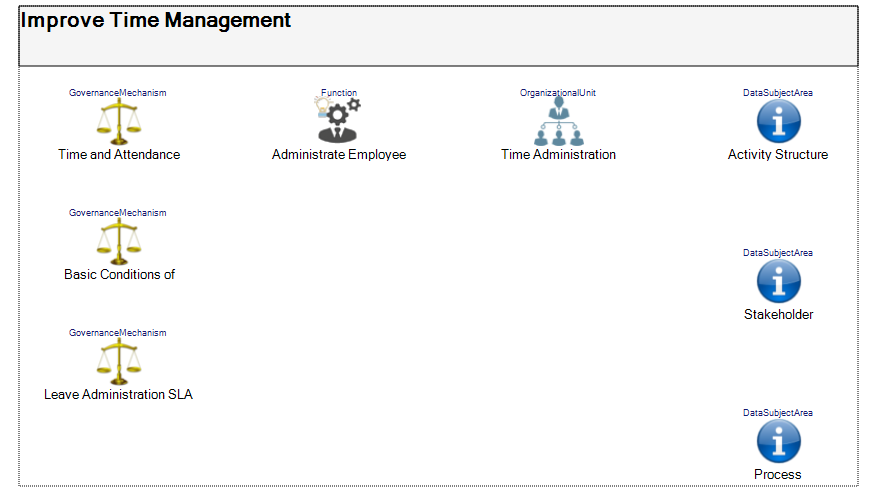
1 Systems
A system can be defined as a collection of different architecture objects that operate
together for a specific purpose (mission or goal) not obtainable by the objects
alone. A system can be classified as a Business System, Information System, Project
and more. The system requires primary and secondary resources as input such as time,
people, data, technology, capital, management mechanisms and services. These resources
act as enablers or constraints. The system is effective if the required outputs
are produced through transformation. The system is efficient if the optimal combination
of resources are utilised.
The system structure is a decomposition of systems that act as a catalog and defines
the scope of systems and context for system engineering or system architecture.


2 Scenario Analysis
A scenario is a collective name for a state that has implied factors and which an
organisation or system is exposed to.
Scenario analysis is an important technique that may be used at various stages of
compiling strategy or for making decisions. Scenarios are typically used to analyse
what the future will entail in order to plan for the future. After analysis of the
probability of realisation of a scenario, a specific scenario(s) is selected that
typically has the highest probability of realisation or alternatively is preferred.
The organisation or system is positioned against this scenario(s).
Scenarios for the future need to be investigated for the business as well as for
technology. Both of these influence change.


3 Environmental Influencing Factors, Implications and CSFs
To truly understand what the scenarios against which we position ourselves mean
to us we need to describe them and explore their potential. The description that
we require on these scenarios are expressed in terms of the influencing factors
(drivers), which are relevant to each of the three-business environments, external,
target and internal. Sub types of external environment influencing factors include:
Political, Economical, Socio Economical, Technology Trends, Legislation, Environmental,
Cultural, Industrial and other. Sub types of target environment influencing factors
include: Competitor, Supplier, Customer, Market and Other Stakeholders. An example
of an driver is a change in regulation or compliance rules which, for example, require
changes to the way an organization operates; i.e., Sarbanes-Oxley in the US.
The internal environment of every business is subjected to these influencing factors
which inevitably affect it and motivates strategy.

The implications of an influencing factor is different for each system given the
architectural definition of its internal environment. The implications are analysed
using the SWOT analysis technique.
The SWOT Analysis is a useful technique to test the performance ability of the system
against the implications arising from the interpretation of the effect that the
environmental factors has on the internal environment. A key distinction must be
made between Internal and External Issues. Strengths and weaknesses are a reflection
of our internal capability. For example, a strength could be our specialist product
offering. A weakness could be the lack of a new product. Opportunities and threats
represent the influence from the external- and target environments. For example,
an opportunity could be to develop a new product, or increase our shoppers from
our customer base, that potentially increase demand for our products. A threat could
be new competition in our market or a technological change that makes existing products
potentially obsolete.

The result of the SWOT Analysis is used to create Critical Success Factors (CSF’s).
CSFs for a business are those things that absolutely need to be achieved in order
to avoid the organisation's “certain death” and to excel in the game. Typically,
these are derived from the identification of potential death threats as well as
the source of core competencies that the business needs to capitalise on in order
to survive.
As an alternative approach one could identify strategic themes. A strategic theme
is the logical grouping of implications deemed to be of strategic importance to
an organisation. These strategic themes then result in CSFs.


4 Measures
A measure is used to track the success of architecture and operational execution
with the strategic intent. Measures can defined be on an area, indicator or value
level. Measurement areas include Performance, Availability, Quality and more. For
architecture management the values are typically used to set targets rather than
to track the measurement values of operational execution on an ongoing basis.
The measures are decomposed and used as a catalog for referencing.


5 CSFs to Measurement Mapping
The success of strategy and the resultant architecture has to be understood and
quantified by some or other yardstick. The realisation of CSFs are measured by a
specific set of measures.


6 Governance Mechanisms
Governance mechanisms are necessary to direct or guide the execution of a system,
to ensure compliance and to ensure that risks are managed appropriately and resources
are used responsibly. Governance mechanism could be of type Policy, Plan, Contract,
Standard Operating Procedure, Control, Standard, Act, Regulation, Framework, Reference
Model ant other. The internally compiled governance mechanism are derived from the
strategy and architecture of a system.
The list of Governance Mechanisms are structured to the appropriate level and act
as a catalog. This level of detail could be down an element level such as a paragraph
within a Policy document.


7 CSF to Governance Mechanism Mapping
Governance Mechanisms such as polices are required to ensure the successful implementation
of strategy that is represented by the CSFs. The mapping of CSFs to Governance Mechanisms
can potentially identify new governance mechanisms that are required or increase
the criticality of existing governance mechanisms.
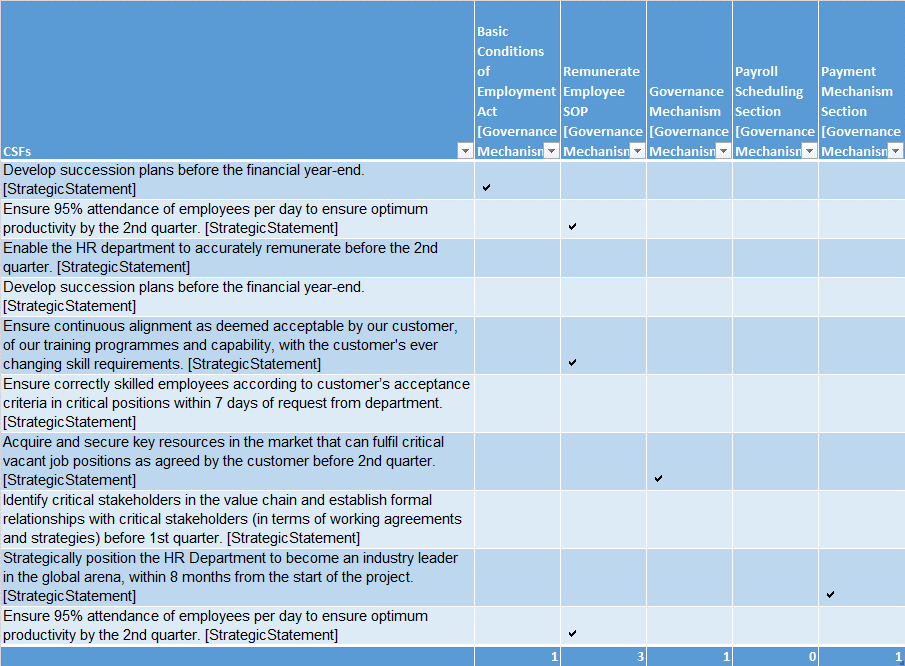

8 Governance Mechanism to Measurement Mapping
The measurement of compliance to governance mechanisms such policies are measured
by a specific set of measures. The mapping can potentially identify new measures
that are required or increase the criticality of existing measures.
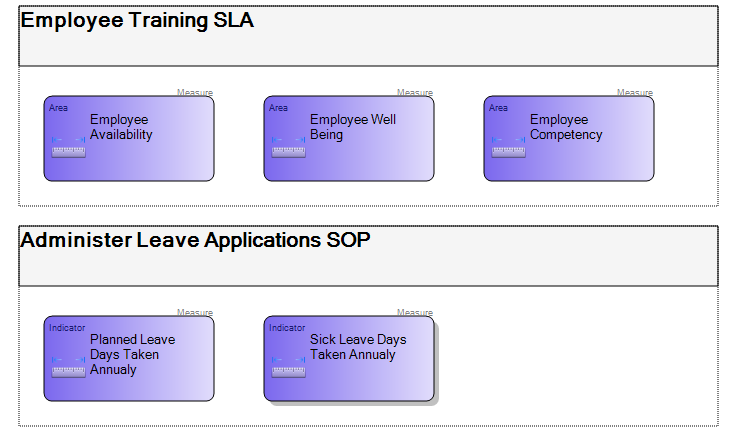

9 Risks
A Risk is defined as a likelihood of a threat of a negative impact (damage, injury,
liability, loss or other negative impact) that will exploit vulnerabilities of the
System and that may be neutralized through mitigating actions. A Risk can potentially
influence the realisation of the strategic intent and compliance with governance.
Within a process a risk represents the possible danger of the process goals not
being achieved. Risks are usually measured by a combination of impact and probability
of occurrence.
Risks are potentially derived from the SWOT Analysis and Function Resource Gap Analysis
techniques.
The structure is a decomposition of risk categories as per a risk framework as well
as the risks themselves. The structure act as a catalog of risks.
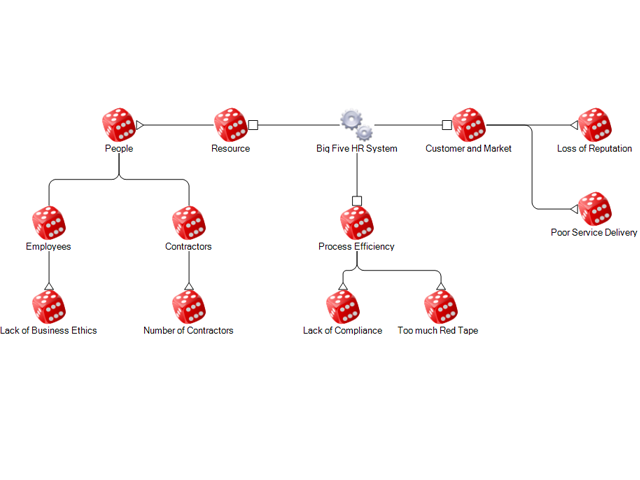

10 Services
A Service references to a set of functions that is managed (and sometimes sold)
as a single component of the system, has an explicitly defined interface and is
explicitly governed. A service has a clear purpose. These services and their corresponding
consumers interact using a well-defined protocol. A service is self-contained and
may be composed of other services. Examples of services are Train Users and Provide
Computing Platform for Applications.
The Services Structure acts as a catalog and should be aligned to the Functions.
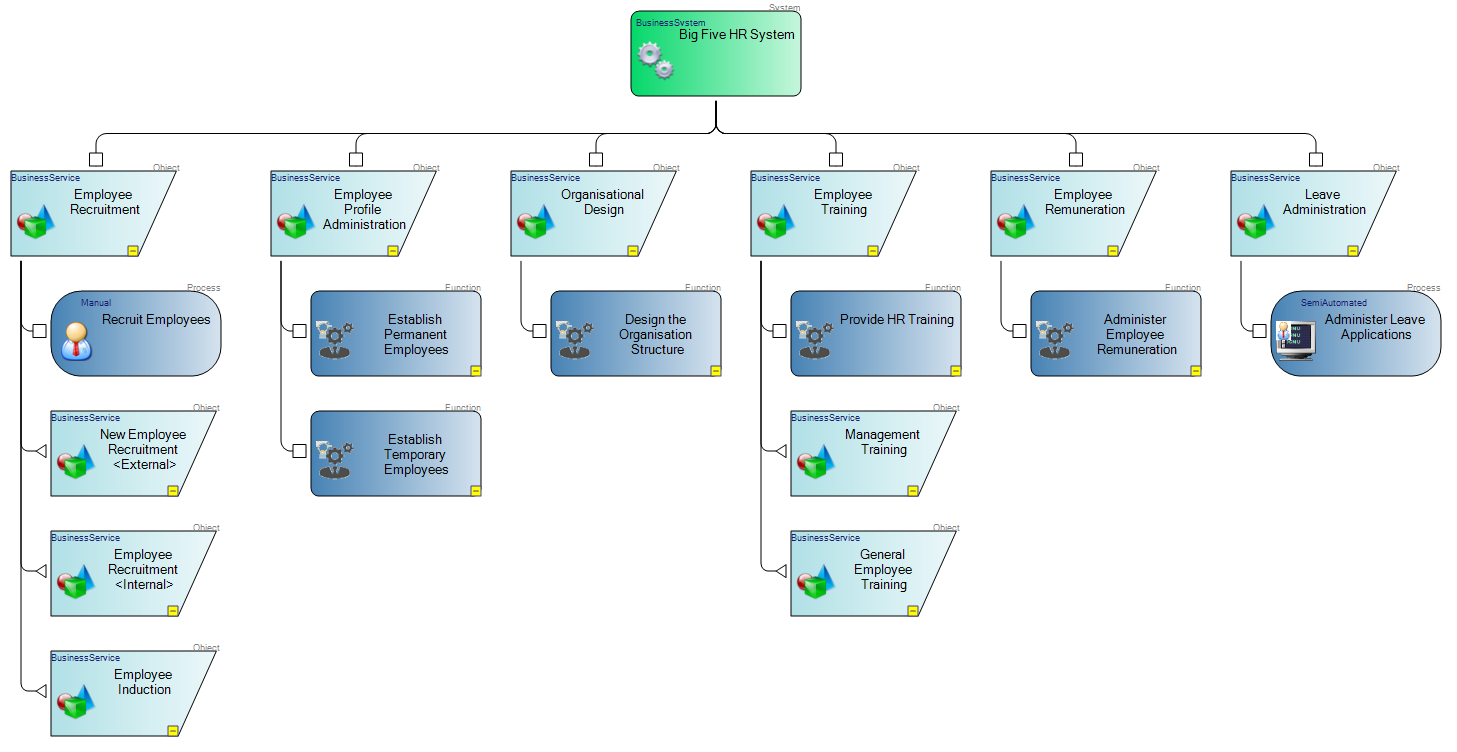

11 Service Channel and Market Segment
It describes in the form of a three dimensional matrix the relevant offerings (products
and services) provided to the relevant market segment (grouping of stakeholders
per dimensions) and which mechanisms (or channels) are used to deliver the particular
offering to the particular market segment.
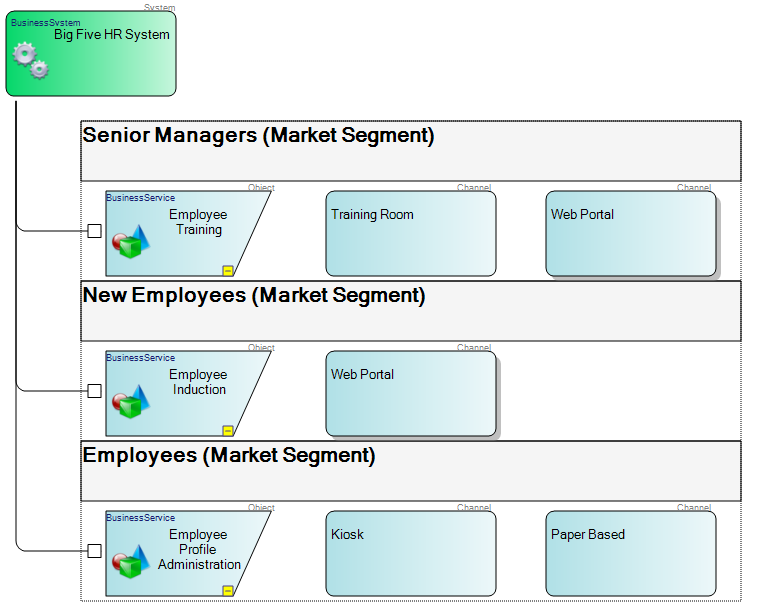

12 Functions
A function is the action or intended purpose of a person or object in a specific
role. It expresses a goal / result that has to be achieved. Is described by a verb
and a qualified object.
Function structuring is necessary to provide scope to a business, information or
project and indicates the complete set of functions required to realise strategy.
The structure represents a decomposition and classification of functions that describes
what needs to be done; and acts as an index mechanism for operational definitions
in the form of for example an operating model or business process.
The different levels of abstraction for functions can include a business goal (function),
process or activity.
Functions can also be represented as a Value Chain step.
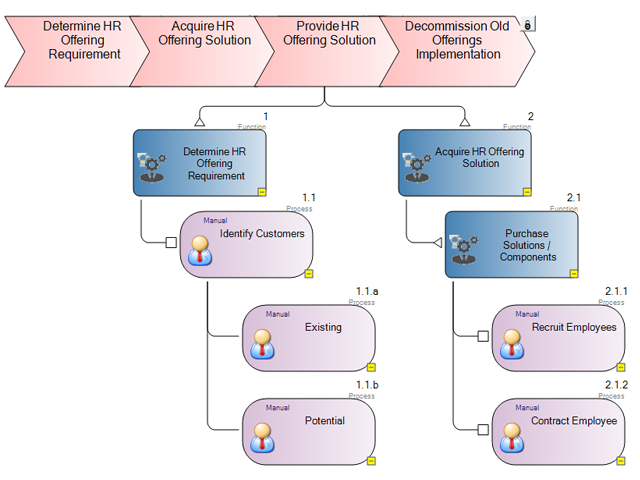

13 Function to CSF Mapping
The purpose of this mapping is to define which functions directly contributes to
the realisation of strategy in the form of CSFs. Functions that contribute to more
CSFs have a higher criticality rating. The result of such mapping indicates the
urgency of each function. The functions, which support the most CSFs, i.e. with
the highest criticality, require more attention in terms of resourcing and the quality
(effectiveness and efficiency) of execution in order to realise strategy.
The mapping also ensure that the set of internal functions to be performed is complete
to realise strategy.
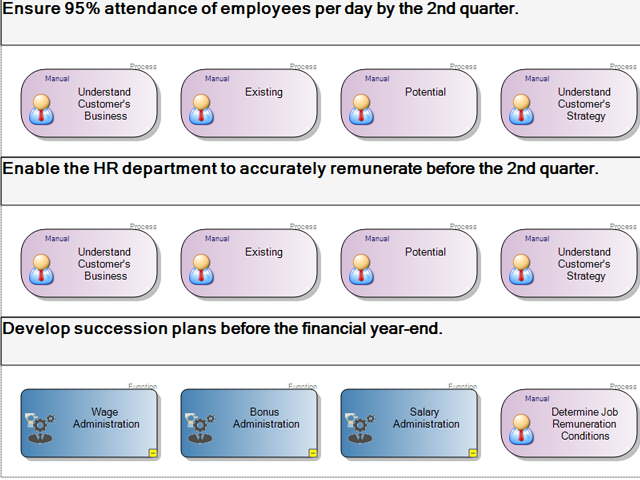

14 Function Resource Gaps
The availability of adequate resourcing is measured along with the overall quality
(effectiveness and efficiency) of execution of the function. This is combine with
the criticality of each function derived from strategy in order to determine the
priority for fixing functions (fix-it priority). The most critical functions with
the largest resource gaps will have the highest priority for fixing. Projects are
initiated to fix resource gaps.
This technique aims to derive a quantitative indication of how sufficient our current
resources are in achieving the business strategy. The resource gaps are plotted
against criticalities of the functions which then will give us a very clear indication
of where the problem areas are, when measured against the ideal set of functions.
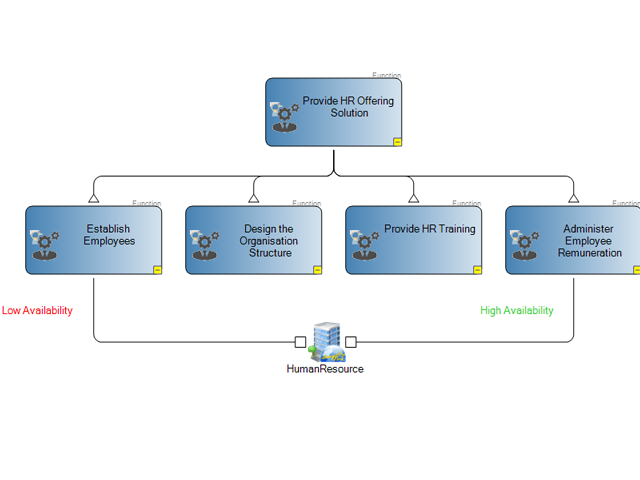
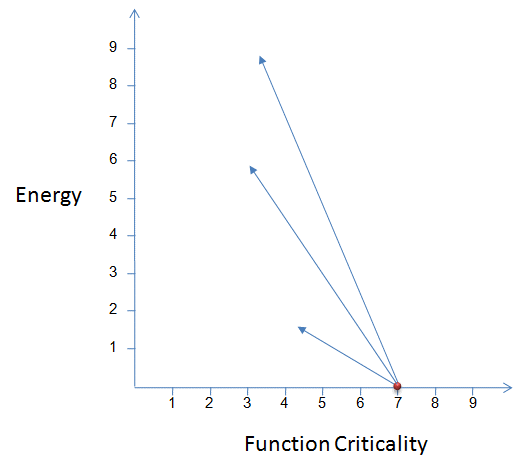

15 Logical Data Model (Attribute Dependencies)
This is a representation of data of a natural construct or system in its smallest
atomic form, on a logical level of detail. It defines the attributes of data entities
(a physical object or event) to further describe them as well as the functional
dependencies (relationships) among the data attributes. Examples of attributes are
Person Name or Delivery Date.


16 Logical Data Model (Attribute Dependencies) with Algorithm Applied
By applying a mathematically based algorithm to the logical data model, certain
outputs are produced that are of value to the business in terms of architecture-
and data management. The model delivers a mathematical verification of the business
rules, architectural priority, data represented in 5th normal form and mathematically
derived business objects that adhere to the object-oriented principles.


17 Conceptual Data Model
Using the logical data model as input, data entities are clustered and abstracted
to represent data on a conceptual level of detail. This can be done for logical
or physical data. These clusters of data (Data Subject Areas) can be reverse engineered
by means of an algorithm or masterminded from a zero base.
Represents a catalog of Data Subject Areas that is an abstraction the more detailed
data attributes and fields. Functional dependencies between The Data Subject Areas
can also be described.
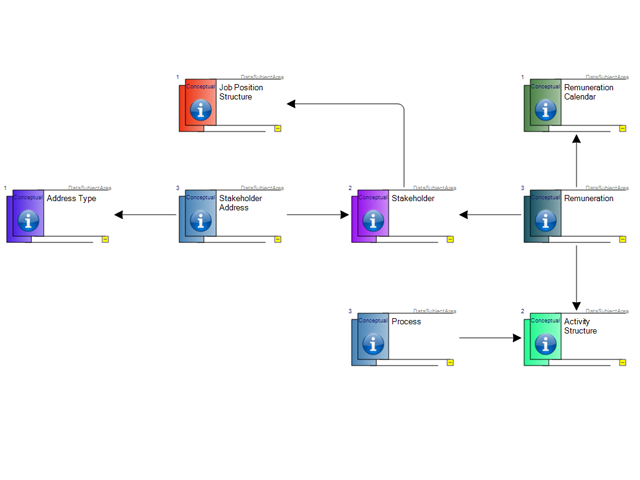

18 Organisation Structure
An Organisation unit is a social unit of people, systematically structured and managed
to meet a need or to pursue collective goals on a continuing basis. It is a self-contained
unit of resources with strategy and measures. An Organisation Structure represent
the hierarchy of units in the organisation. Organization units may include external
parties and business partner organizations. Sub types include: divisions, business
areas, operating units, departments, sections and sub-sections.
Organisation units are further describe by the roles / functions they fulfil and
the jobs, positions and persons contain in them. A position represents an instance
of a job. Jobs fulfil roles that are contained in a process. Roles should have functions
allocated to it. A job, role or person has a set of actual or expected competencies
(skills, experience, knowledge, qualifications, etc.) A person, job or organisation
unit may have multiple roles to fulfil, for example the roles of Configuration Manager
and Change Manager may be carried out by a single person.
An organisation structure act as a governance mechanism for aspects such as delegations
of functions and reporting lines.
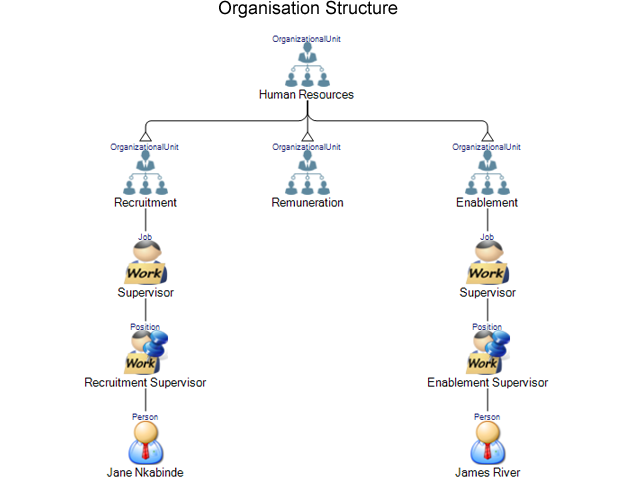

19 Organisation Unit to Risk Mapping
Organisation units are expected to manage the risks that are applicable to them.
The mapping can potentially identify new risks that need to be mitigated by the
organisational unit while performing its functions. The risk rating for the same
risk can be different between between organisation units.


20 Location Scheme
A location scheme standardises the way of referencing locations. The location units
and the relationship between the location units are described. Examples of location
schemes are: Warehouse Location Scheme, Geographical Location Scheme and Mining
Location Scheme. The units for a Warehouse Location Scheme is for example: Warehouse,
Aisle, Shelve and Bin.
References to the physical locations as per location scheme. Each location has an
address. Example: South African Geographical Structure (Gauteng, Pretoria, Irene,
Justice Mohamed Street, ...)
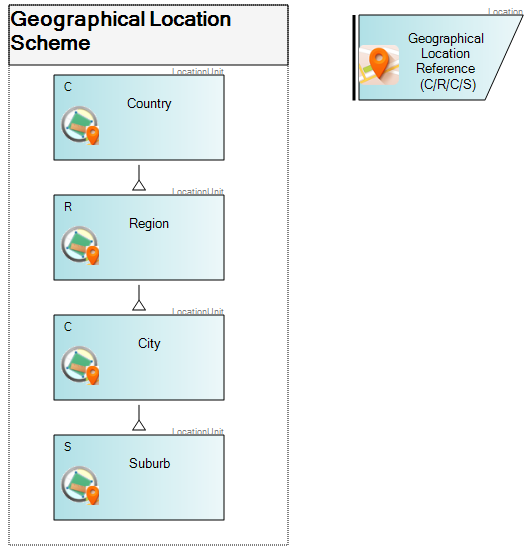

21 Locations
Provides for a decomposition of all locations where an organisation performs business
operations or houses architecturally relevant assets, such as data centers or end-user
computing equipment. Maintaining a definitive list of locations allows change initiatives
to quickly define a location scope and to test for completeness when assessing current
landscapes or proposed targeted solutions. For example, a project to upgrade desktop
operating systems will need to identify all locations where desktop operating systems
are deployed. Similarly, when new systems are being implemented, a listing of locations
is essential in order to develop appropriate deployment strategies that comprehend
both user and application location and identify location-related issues, such as
internationalization, localization, timezone impacts on availability, distance impacts
on latency, network impacts on bandwidth, and access.
It is required in business to associate localities with one another for a multitude
of business reasons. A branch can be associated with the head office in terms of
the cost of travel by air between the two localities, the bandwidth of the network
link between them, the combination of the governance mechanisms enforced from head
office on this particular branch, the road distance, the business continuity requirements,
etc.


22 Time Scheme
Time refers to when something needs to be done. Time schemes standardise the way
of referencing to time. The time units and the relationship between the time units
are described. Natural Time Calendar, Financial Calendar or Work Calendar are examples
of time schemes. The time units included in a Financial Calendar is for example
a Financial Year, Financial Quarter, Financial Month and Financial Day.
Time units of time schemes can also be related to one another.


23 Other Resources
Resources are used as primary or secondary input to enable a system. Resources need
to be used in an optimal manner to establish an efficient system. Other than for
Services, People, Data, Time, Management Ability and IT the other classes of resources
include amongst other Natural Resources, Raw Material, Equipment, Facilities, People
and Capital.
Depicts a decomposition of all the resource categories and the instances that could
be used as inputs, enablers or as outputs of a system.


24 Object Interfaces
An alternative approach to process modelling is to classify all elements that form
part of a process as objects and then to focus on the functions they perform and
the interfacing between them. Due to the fact that all the dimension are represented
as an object, the process definition is simplified.
Objects interact with each other by means of flows. The objects and flows are further
classifying into the relevant classes.


25 System Operation
A system operation represents the integration of elements from the other facets:
Strategy, Function, Data / Information, Organisation, Location, Time and Object.
This forms a coherent process operation to ensure balance between all the elements
defining the internal operation of a system. A process represents flow of control
between or within functions. Processes represent a sequence of functions that together
achieve a specified outcome.
The basic layout of a process consists of Triggers; Inputs or Pre-conditions; Internal
Operation; Outputs, Post Functions and Post-conditions.
A logical system operation typically has now reference to any physical components
and also does not account for any of the constraints of the physical environment.
One of the primary views that can be obtained from the system operation is where
data attributes are associated to function via an information artefact. This mapping
enables the following to take place: Assign ownership of data to stakeholders; Understand
the data and information exchange requirements between functions; Support the gap
analysis and determine whether any data is missing and need to be created; Define
application of origin, application of record, and application of reference for data
entities; Enable development of data governance programs across the enterprise (establish
data steward, develop data standards pertinent to the business function, etc.).
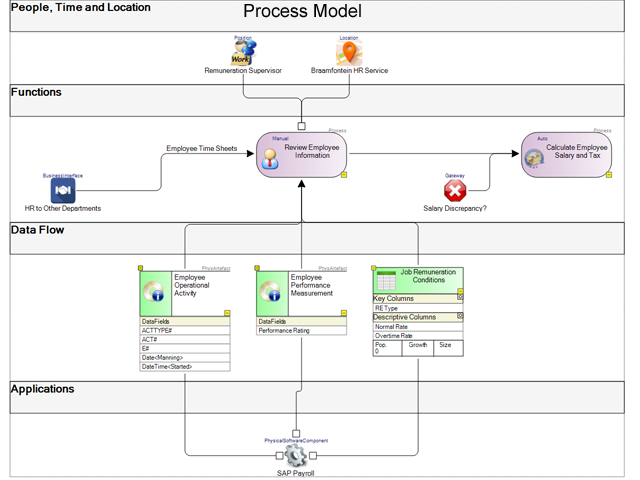

26 Software Components
A software component is a collection of executable programs that enables and facilitate
the use of the computer devices. Software controls the operation of the hardware
and the processing of data. Subtypes include Applications and Base IT Infrastructure
Software.
The structure acts as a catalog of components.
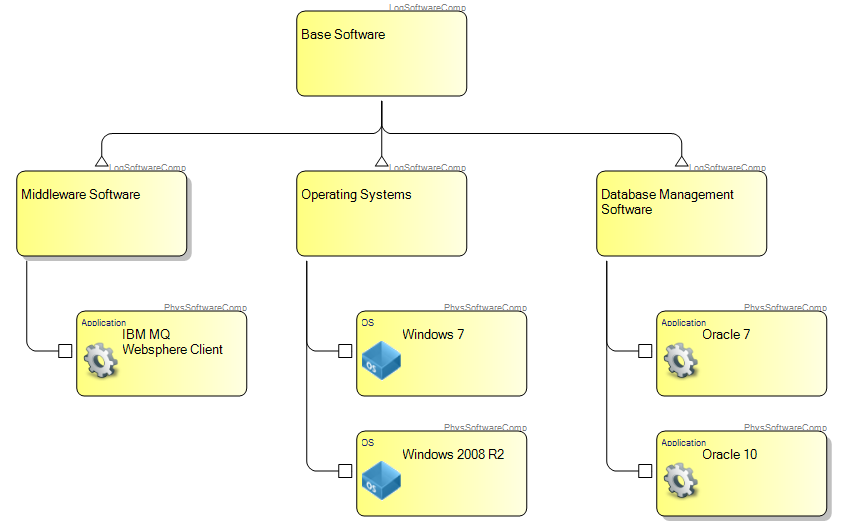

27 Application to Function Mapping
The purpose of the Application to Function Mapping is to depict the relationship
between applications and functions that they perform within the organisation. Some
of the functions will be supported by applications. This mapping typically enables
the following to take place: Assign usage of applications to the business functions
that are supported by them; and Enables gap analysis by determining whether applications
or application functionality are missing and as a result need to be acquired.
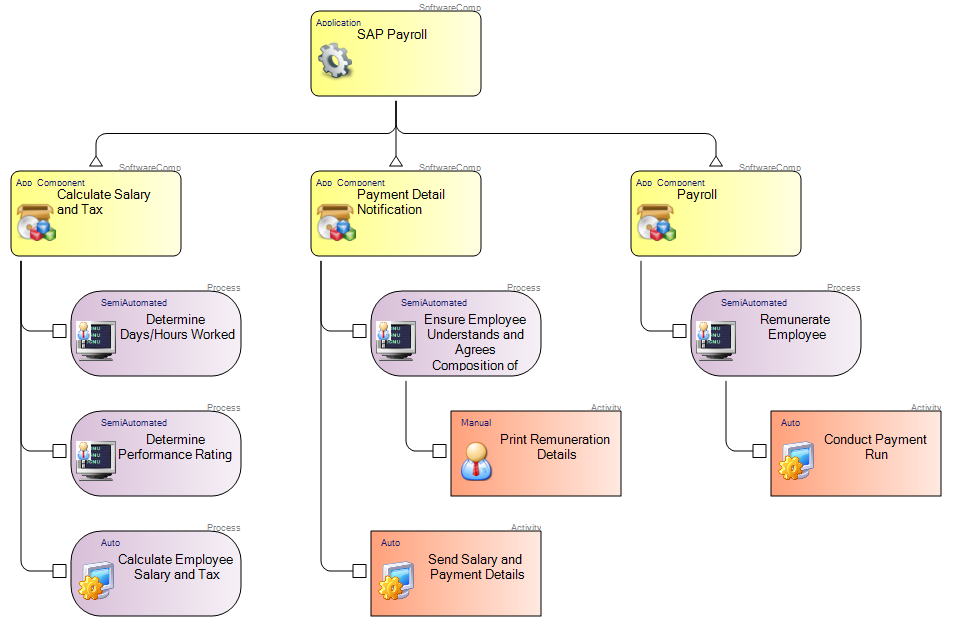

28 Algorithmic Structure
An Algorithmic Structure is used to define the internal view of any function, process,
algorithm, etc. where complex algorithmic logic in terms of sequence, condition,
repetition and synchronisation is needed. The structure can be constructed on each
of the three architecture levels to depict algorithmic logic applicable at that
specific level. The most general application of the technique is to depict program
structure or logic for application design and development.
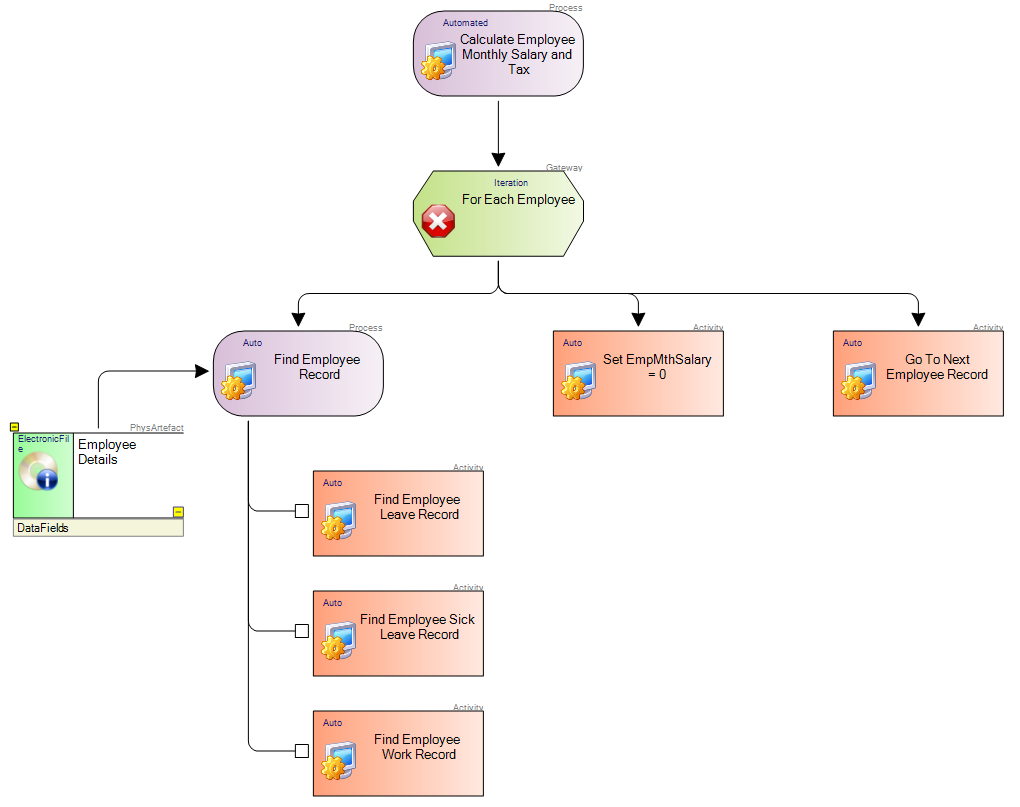

29 Data Components
Data and information is stored in a physical data construct that allows for storing
a specific set of data values. Subtypes include: Database, Data Warehouse, Data
Mart or Operational Data Store.
Acts as a catalog of physical data components.
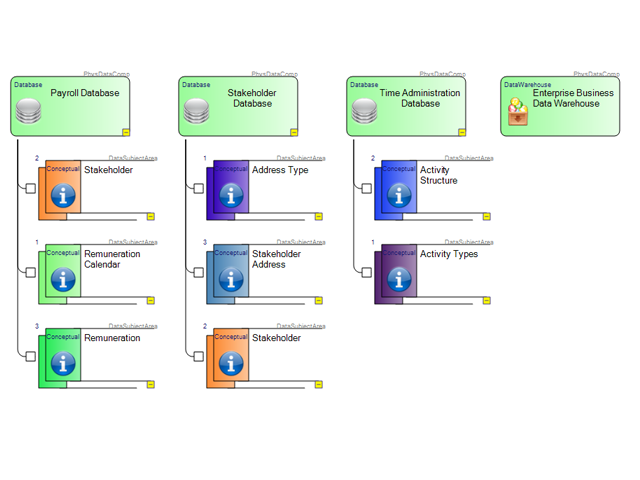

30 Data Structure
The structure of data components can be described by means of table, fields and
the relationships between them. The logical data structure has not been influenced
by any of the physical constraints of the environment and typically represents a
normalised view of the data. A physical data structure is described by means of
a formal language supported by the management system for the specific physical data
component.


31 IT Infrastructure
A description of the logical or physical components that are deployed to host software
and data. The IT infrastructure components can be classified as computing, network,
data storage or peripheral components as well as the base software installed on
these components.
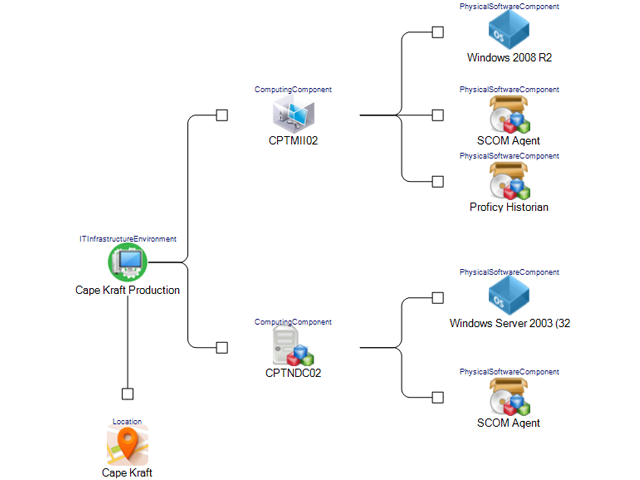

32 Network
A Network refers to a physical network, i.e. a specific LAN or WAN or a named VLAN.
Physical Hardware Components are connected to each other in a network such as routers,
switches and hubs.
The network is the enabler for electronic communication between software and data
component.
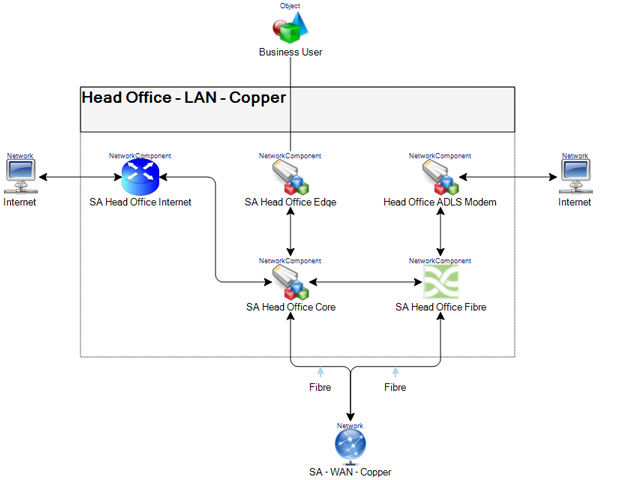

33 Application Interfaces
Identifies and describe electronic communication between applications and data components.
Data can be associated with interfaces by means of an information artefact. Application
interfaces form an integral part of the system operation.
The mapping of the Application Interfaces enables the following to take place: Understand
the degree of interaction between applications, identifying those that are central
in terms of their dependencies on other applications; Understand the number and
types of interfaces between applications; Understand the degree of duplication of
interfaces between applications; and Identify the potential for simplification of
interfaces when considering the target Application Portfolio.
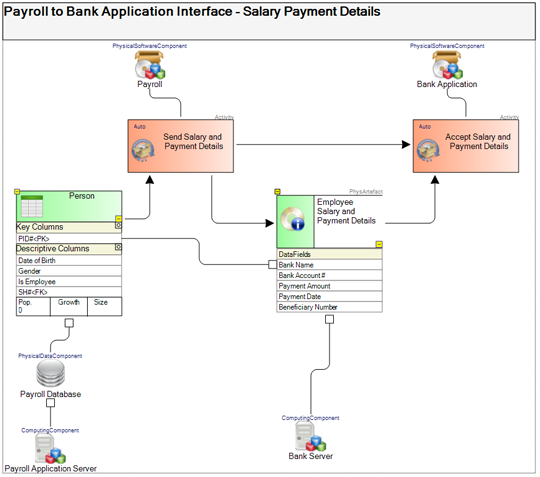

34 Application Interface Stakeholders
A Stakeholder is a person, position, job, or organization unit that has a direct
or indirect stake in a system or object because it can affect or be affected by
the outputs of the system or characteristics of the object. The stakeholder roles
typically include owner, user, custodian, manager, etc. Stakeholders can be defined
for a Project, Business System Information or even object such as IT Infrastructure.
In this case it is done for an Application Interface.
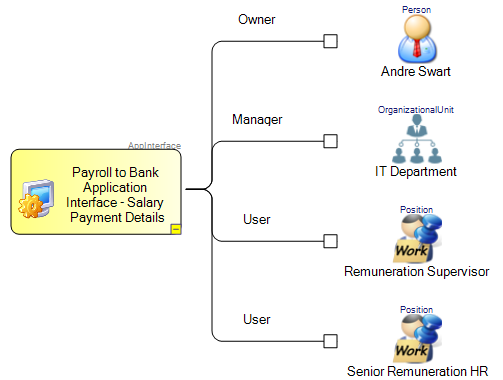

35 Work Packages
A Work Package is a set of actions identified to achieve one or more objectives
for the business. A work package can be a part of a project, a complete project,
or a program.
Work packages are created for changing the system or for ongoing operational execution.
Ongoing execution work packages implies that business process are already available
but the scope of what needs to be executed is defined in the work packages. E.g.
For a process for installing base software on a server the work package scope is
equal to the servers that need base software installed.
A Work Package for a change to the system is typically the link between the Architecture
and Project Management disciplines. By managing this link we can realise benefits
such as: manage the scope of the project, identify projects that will influence
on the same objects, get context and detailed content for all the objects in scope,
etc. A subset of the architecture objects form the scope of the change required.
Acts as a catalog of Work Packages for change or operational execution.
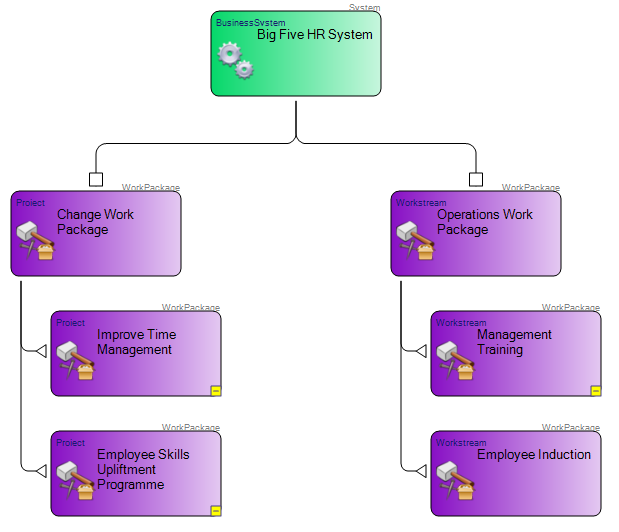

36 Requirements, Assumptions and Constraints
The model captures elements that the enterprise needs in order to realise its strategy
(such as CSFs). The elements are stated in a narrative format. Requirements generated
from architecture engagements are typically implemented through change initiatives
identified and scoped. Requirements can also be used as a quality assurance tool
to ensure that a particular architecture is fit-for-purpose. This must be complemented
by well architecture models that describe the system in a more structured manner.
Architecture content should have traceability (mappings) to any requirements that
might have been gathered if this particular approach is adopted.
A constraint is a factor that prevents an organization from meeting its goals. For
example, customer data is not harmonized within the organization, regionally or
nationally, constraining the organization’s ability to offer effective customer
service.
An assumption is a statement of probable fact that has not been fully validated
at this stage, due to external constraints. For example, it may be assumed that
an existing application will support a certain set of functional requirements, although
those requirements may not yet have been individually validated.
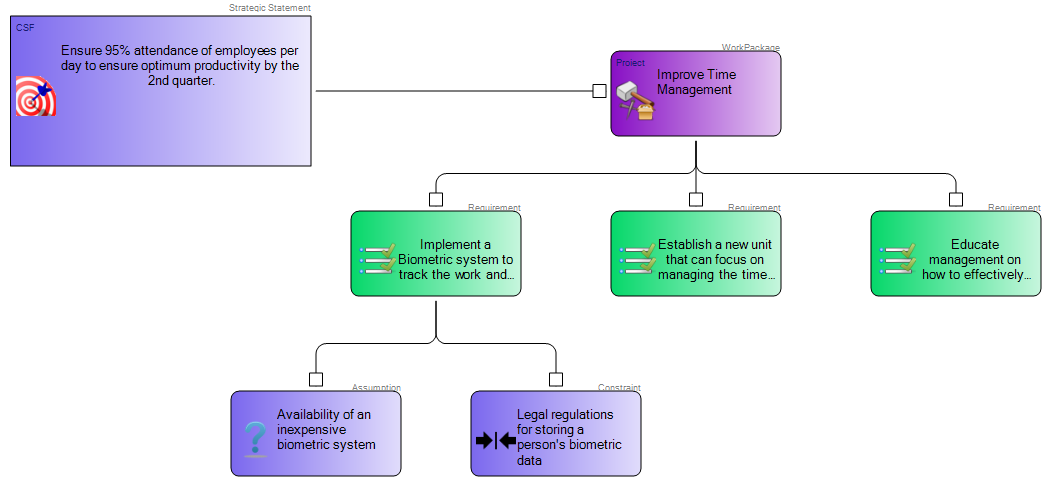

37 Work Package Specification
The Work Package Specification provides a high-level orientation of the solution
that is envisaged in order to meet the objectives of the work package. In contrast
to the more formal and detailed architecture content developed, this represents
a ‘‘pencil sketch’’ of the expected solution at the outset of the engagement. This
highlights what needs to be analysed and designed in more detail with formal architecture
modelling. The purpose of this diagram is to quickly on-board and align stakeholders
for a particular change initiative, so that all participants understand what is
the scope of the architecture engagement. An object in scope can be added, changed,
re-used, removed or merged.
